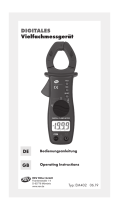29
Table of Contents
Introduction ............................................................................................................................................28
Intended Use ........................................................................................................................................30
Operating Controls..................................................................................................................................31
Safety Information ..................................................................................................................................32
Product Description ..............................................................................................................................34
Scope of Delivery ..................................................................................................................................35
Display Indications and Symbols ..........................................................................................................35
Measuring ..............................................................................................................................................36
a) Switching on the Measuring Instrument ......................................................................................36
b) Voltage Measuring “V” ................................................................................................................37
c) Current Measuring “A“ ................................................................................................................38
d) Resistance Measuring ................................................................................................................39
e) Diode test ..................................................................................................................................40
f) Continuity Check ........................................................................................................................40
g) Contact-Free IR-Temperature Measurement ..............................................................................41
MAX Button ......................................................................................................................................43
MODE Button ..................................................................................................................................43
HOLD Button ....................................................................................................................................43
RANGE Button ................................................................................................................................43
Auto Power OFF Function ................................................................................................................43
Display Illumination ..........................................................................................................................44
Cleaning and Maintenance ....................................................................................................................44
General Information ........................................................................................................................44
Cleaning ..........................................................................................................................................44
Opening Meter ................................................................................................................................45
Replacing the Fuse ..........................................................................................................................45
Inserting/Changing the Batteries ..........................................................................................................46
Disposal ................................................................................................................................................47
Disposal of Used Batteries! ..............................................................................................................47
Troubleshooting ....................................................................................................................................48
Technical Data ......................................................................................................................................49




















